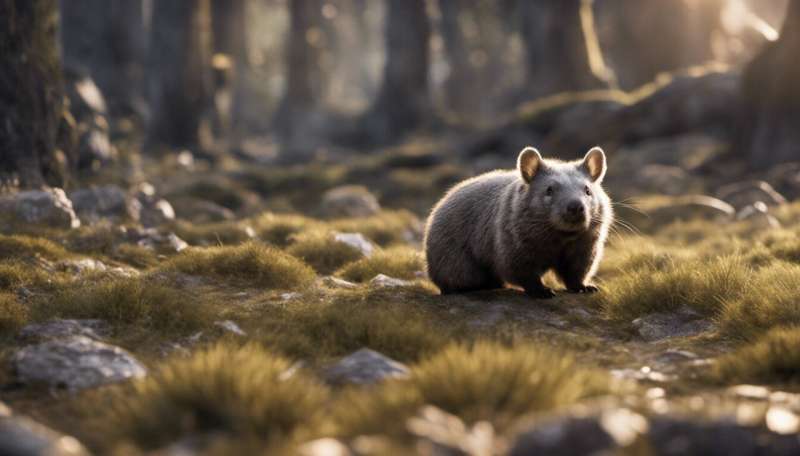Debunking the viral tales of wombat 'heroes'

If you've been following the bushfire crisis on social media and elsewhere, you may have seen reports of herding other animals to shelter into their fire-proof burrows.
These stories went quickly viral—probably reflecting the appetite for good news after the horrors of the bushfire crisis. However the accounts are not entirely accurate.
Wombats do not heroically round up helpless animals during a bushfire and lead them to safety. But wombats do help other animals in a different way—even if it's not their intention.
Accidental heroes
Wombats can emerge as accidental heroes during a bushfire, by providing a safe refuge underground for other wildlife.
Wombat warrens—networks of interconnecting burrows—are large and complex, and considerably shielded from the above-ground environment. Small mammals are known to to survive an inferno.
of the , for instance, found warrens with 28 entrances and nearly 90 metres of tunnels.
What's more, temperatures deep within burrows are very stable compared to surface temperatures, with daily temperature fluctuations of less than on the surface.
This thermal buffering would help a great deal during intense fires, and you can understand why other species would want access to these safe havens.
The wombat sharehouse
By placing camera traps outside 34 wombat burrows, showed a surprising variety of animals using southern hairy-nosed wombat burrows. Researchers observed ten other species, six of which used them on multiple occasions.
The intruders ranged from rock wallabies and to skinks and birds. were recorded using burrows 27 times, while the was observed using wombat burrows more often than wombats—nearly 2,000 visits in eight weeks! They were even observed using the burrows to specifically avoid birds of prey.
But wombats aren't alone in providing real estate for other species. , , , and numerous invertebrates using the warrens of bettongs and bilbies in arid Australia.
Anybody home?
It's also important to recognize wombats don't have "a burrow". Rather, they have within their . In fact, a 2012 study tracked one wombat to .
While wombats are often regarded as quite sedentary, found the average home range size of common wombats is 172 hectares.
They spend sleeping in one burrow, before moving onto another.
Since each wombat has multiple burrows, many can be vacant within a home range, and are common in some areas. showed that even among "active" burrows (those with signs of recent use), only one in three are actually occupied by a wombat at any given time.

This means, at times, other species may not need to share burrows with wombats at all. It's vacant real estate.
So how might a wombat react to an uninvited guest? This is difficult to know, and likely depends on who's visiting. Wombats prefer not to share burrows with other wombats, although burrow sharing when wombat populations are very high in one place.
In her book , Barbara Triggs recalls a fox being chased from a burrow by an angry wombat. Meanwhile, the crushed skulls of foxes and dogs in wombat burrows suggest not all intruders are welcome.
That a suite of species use wombat burrows suggests wombats may not notice or care about squatters—so long as they don't pose a threat. But more research is needed on the fascinating interactions that take place in wombat burrows, particularly during fire.
The battle is not over
While empirical studies are needed, the available evidence suggests wombats may well provide an important refuge for other wildlife during fire.
In any case, it's important to recognize that surviving fire is only half the battle.
Wombats and their house guests face a medley of challenges post-fire—not least avoiding predators in a barren landscape and eking out a living in a landscape with scarce food.
Provided by The Conversation
This article is republished from under a Creative Commons license. Read the .![]()




















